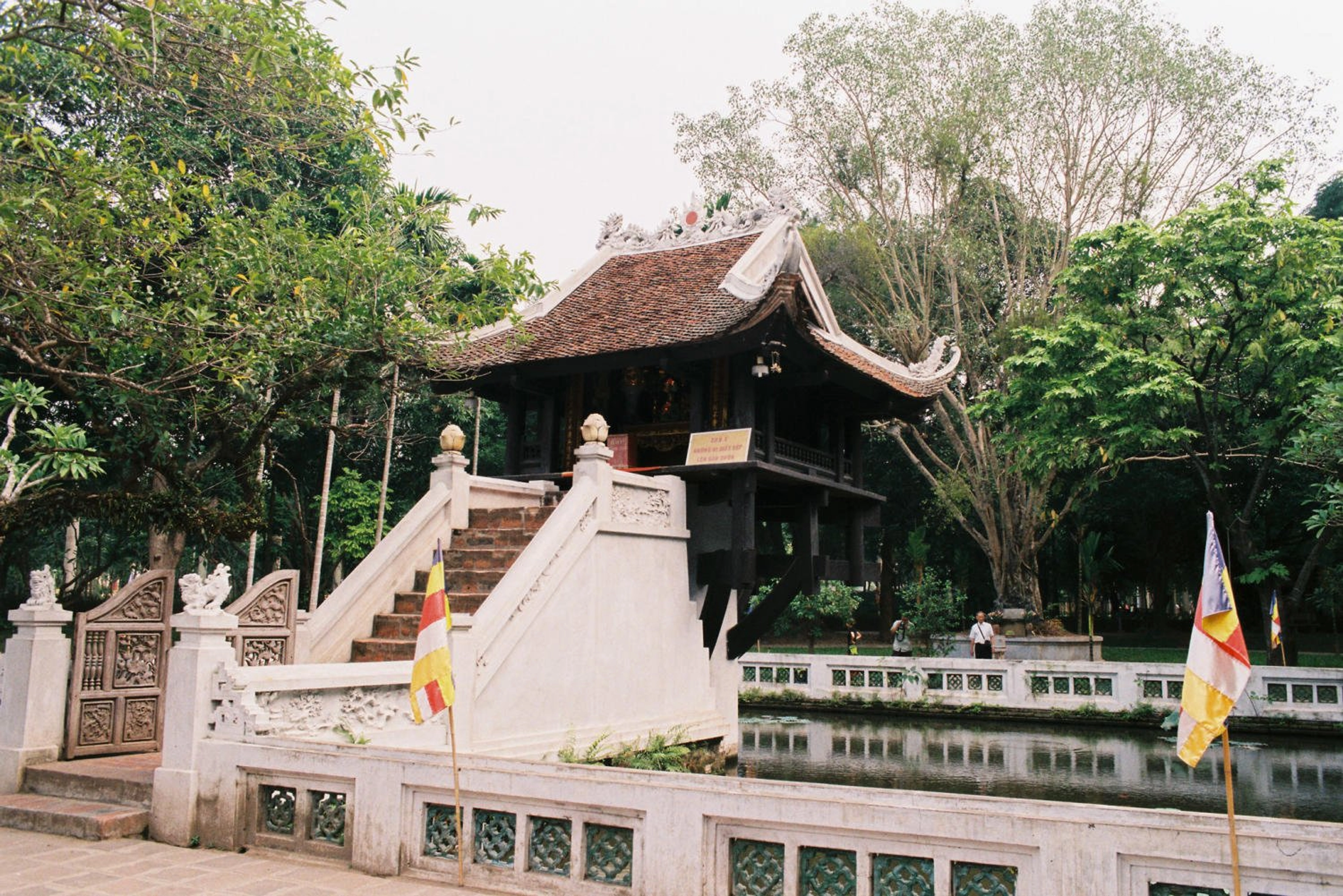

One Pillar Pagoda is one of the most famous pagodas in Hanoi, with a unique architecture and a great historical value. Join BDATrip to learn about the history, architecture, meaning and interesting experiences when visiting this pagoda!
One Pillar Pagoda: The architectural and spiritual treasure of the capital
History of One Pillar Pagoda
Located at number 24, Doi Can street, Doi Can ward, Ba Dinh district, about 2km from the city center, can easily be reached by personal vehicle or public transport, One Pillar Pagoda is a unique and sacred pagoda, built on a 4-meter-high Lim wood pillar, in the middle of a small pond. The pagoda’s original name is Dien Huu Tu, meaning “Long-lasting Happiness” or Lien Hoa Dai, meaning “Lotus Platform”. The pagoda is considered as a symbol of the eternity and immortality of Buddhism and the Ly dynasty.

Dien Huu Tu worships the Goddess of Mercy Quan Am, the compassionate Buddha who saves the suffering and grants blessings to all beings. According to legend, in 1049, King Ly Thai Tong dreamed of seeing the Goddess of Mercy Quan m sitting on a lotus and leading him to the throne. After waking up, he told his dream to his officials and was advised to follow it. He ordered the building of a tall Lim wood pillar, on which was a stone lotus platform to worship the Goddess of Mercy Quan m. Around the pagoda, there were monks walking around chanting sutras to pray for protection.
In 1105, King Ly Nhan Tong ordered the renovation of the pagoda and added two white porcelain towers in front of it. In 1108, Nguyen Phi Y Lan cast a large bell named “Giac The Chung”, with the wish to help humanity awaken.
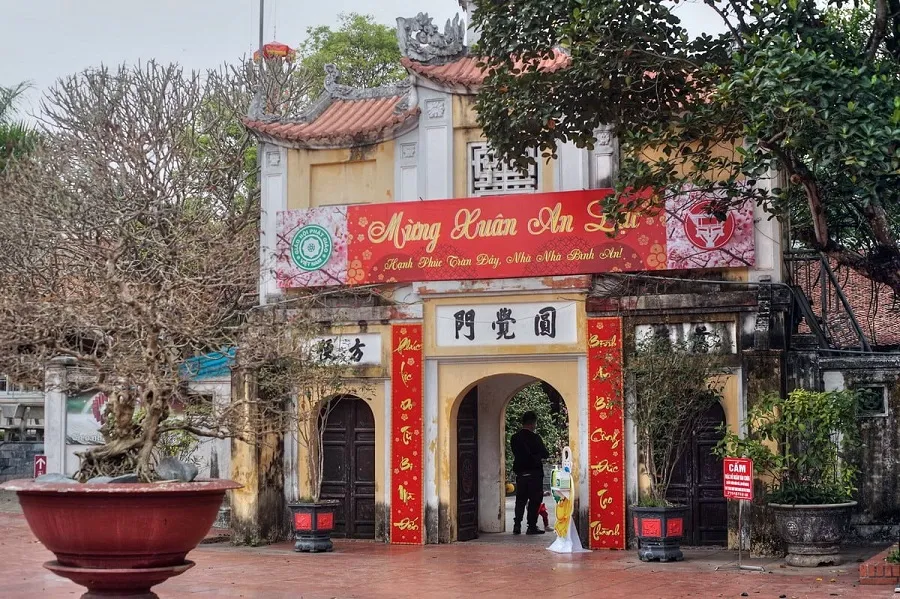
Next to the pagoda, there is a small pagoda with a three-gate entrance and a horizontal board carved with three characters “Dien Huu Tu”. Inside this pagoda, there is a statue of Buddha Shakyamuni meditating made of Lim wood, 1.2 meters high, considered as a high-quality artistic sculpture of the Ly period.
Significance of One Pillar Pagoda in Vietnamese culture
Spiritual value
Not only a symbol of everlasting and indestructible, but One Pillar Pagoda in Hanoi is also a pride of the Vietnamese people, witnessing the glorious history of the Ly dynasty.
Dien Huu Tu brings visitors special spiritual experiences. Many people believe that the pagoda has prosperous feng shui, bringing luck and peace to those who visit. Especially, those who wish to have children or sons often come to the pagoda to ask for the Goddess of Mercy Quan m to grant their wishes. In addition, the pagoda also has a statue of Buddha Shakyamuni meditating, which is said to be able to ward off evil, dispel bad luck and make life smooth.
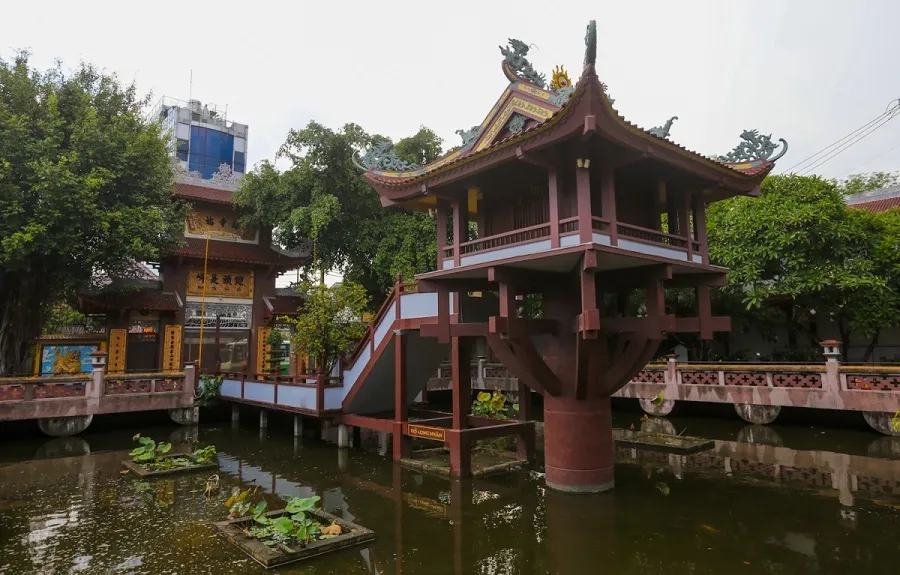
When visiting the pagoda, you will immerse yourself in a peaceful and serene space, feel the joy and happiness in your soul. You can also light incense, worship, listen to sutras and participate in Buddhist activities at the pagoda.
Cultural and historical value
One Pillar Pagoda is a symbol of the Ly dynasty, the golden age of Buddhism in the history of the Vietnamese nation. The pagoda was built in 1049, during the reign of King Ly Thai Tong, based on his dream of meeting the Goddess of Mercy Quan m. The pagoda was renovated and developed further in later dynasties such as Tran, Le, Nguyen.
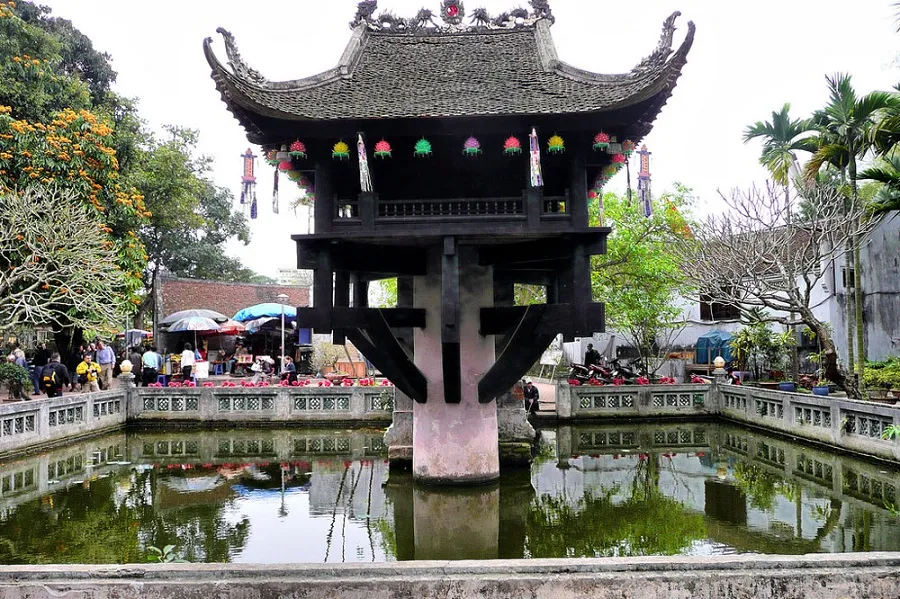
Throughout the changes of history, Dien Huu Pagoda witnessed many historical events of the Vietnamese people. The pagoda was destroyed by the Chinese invaders in 1406, and burned by the French colonialists in 1954. However, the pagoda was rebuilt in 1955 and recognized as a national historical and cultural relic in 1962 as well as becoming one of the most famous pagodas in Hanoi.
Where is One Pillar Pagoda? Directions to the pagoda
Dien Huu Pagoda is located within the premises of Ho Chi Minh Mausoleum, in Doi Can ward, Ba Dinh district, Hanoi city. To get to the pagoda, you can use various means of transportation such as:
- Bus: You can take bus number 09, 18, 22, 33, 45, 50 or 90 and get off at Lang Bac bus stop. Then, you walk about 300 meters to the pagoda.
- Motorcycle: You can go along Nguyen Thai Hoc street, turn into Chua Mot Cot street and park your motorcycle at the parking lot near the pagoda. You need to note that, on holidays or weekends, the roads are usually very crowded and difficult to travel, so you should go early to avoid traffic jams.
- Taxi: You can call a taxi or use apps like Grab, Gojek, Be to get to the pagoda. You should ask the driver to pick you up and drop you off at the gate of the pagoda for convenience.
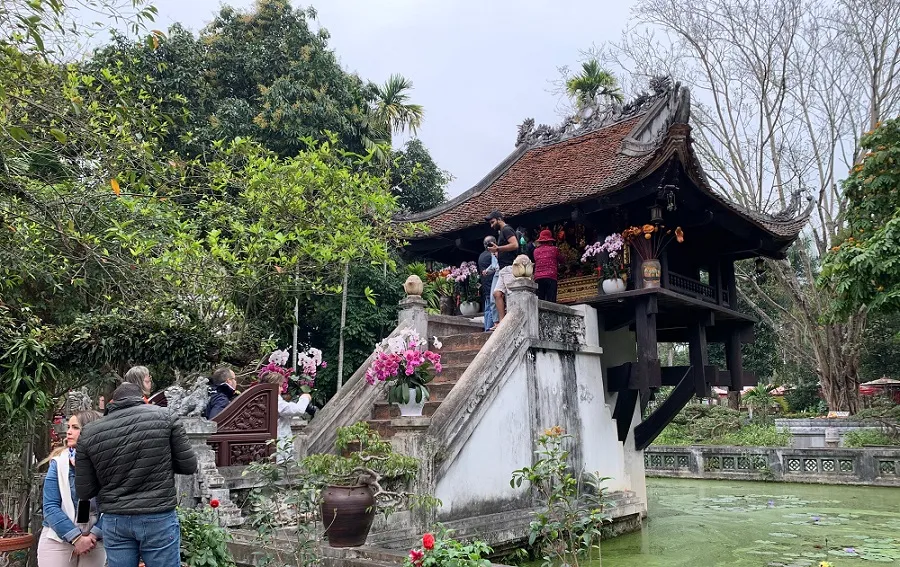
Lotus Platform and the architectural detail of “one pillar”
Three-gate entrance
To enter the premises of the pagoda, you have to go through the three-gate entrance. The three-gate entrance has three wings, of which the middle one is only for monks and high-ranking guests, while the two sides are for ordinary visitors. On top of the three-gate entrance, there is a sign that says “Dien Huu Tu”, which is the original name of the ancient One Pillar Pagoda.
Sturdy and solid pillar
The pillar is the main part of this pagoda, which supports the entire structure of the Lotus Platform. The pillar is made of Lim wood, with a diameter of 1.2 meters, and a height of 4 meters. The pillar is decorated with patterns and images of Buddhism, such as dragon heads, lotus flowers, prajna paramita sutra. The pillar is painted yellow, representing nobility and elegance, this is also the symbol of the cosmic axis, symbolizing the worldly axis and the spiritual axis.
Lotus Platform
The architecture of One Pillar Pagoda is famous for its Lotus Platform, which is a small pagoda supported by a pillar, shaped like a lotus flower blooming in the water. The Lotus Platform has a size of 3 x 3 meters, and a height of 3.5 meters. The Lotus Platform has two floors, the lower one is for worshiping the Goddess of Mercy Quan Am, and the upper one is for worshiping Buddha Shakyamuni, the lotus is a symbol of Buddhism, symbolizing enlightenment and liberation.
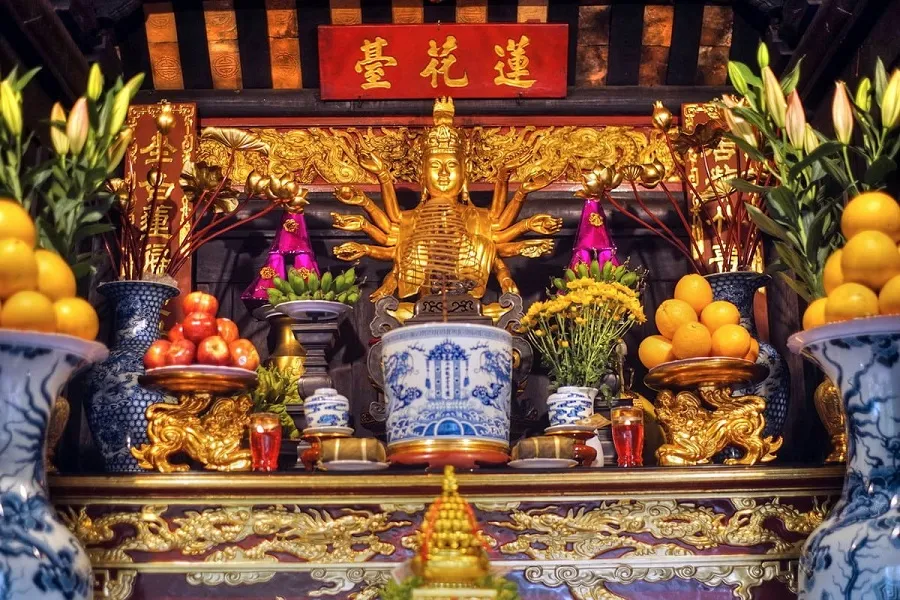
Inside the Lotus Platform, there is a bronze statue of the Goddess of Mercy Quan m, 1.2 meters high, cast again in 1955 according to the shape of the old statue that was stolen by the French colonialists. The statue of the Goddess of Mercy Quan Am is loved and respected by the people, considered as the Buddha who protects and blesses all beings.
Dragon scale tiles create a highlight
The roof of One Pillar Pagoda is covered with dragon scale tiles, green in color, shaped like bird wings flying. The roof has two sections, the front section is higher than the back section. On the roof, there are bells and ritual instruments hanging, creating a melodious sound when the wind blows.
Linh Chieu Pond
Linh Chieu Pond is a pond that surrounds the pillar and the Lotus Platform, with an area of about 1000 square meters. Linh Chieu Pond symbolizes the purity and clarity of Buddhist teachings. In the pond, there are many lotus flowers and green trees, creating a peaceful natural space.
Unique travel experiences at One Pillar Pagoda
One Pillar Pagoda is not only a unique and sacred architectural work, but also a place where you can experience many attractive and meaningful activities such as:
- Lighting incense, worshiping, praying: Visitors can buy incense and flowers at the stalls near the pagoda, then light incense and worship at the Lotus Platform to pray for peace, luck and happiness for themselves and their families, or they can draw a fortune stick to see their destiny.
- Listening to sutras, participating in Buddhist ceremonies: Visitors can listen to sutras and participate in Buddhist ceremonies at the pagoda on the full moon or the first day of each month. You will hear the profound and subtle teachings of Buddhism, as well as immerse yourself in the pure and sacred atmosphere of the pagoda.
- Taking souvenir photos: Visitors should choose beautiful angles to take photos, such as the three-gate entrance, the pillar, the Lotus Platform, Linh Chieu Pond, or the roof of the pagoda. You should also pay attention not to disturb or violate the worship items or historical artifacts in the pagoda.
- Enjoying cuisine: You can try some specialties of Hanoi, such as pho, bun cha, bun thang, banh cuon, banh mi, or vegetarian dishes of the monks, such as vegetarian rice, vegetarian noodles, vegetarian cakes.
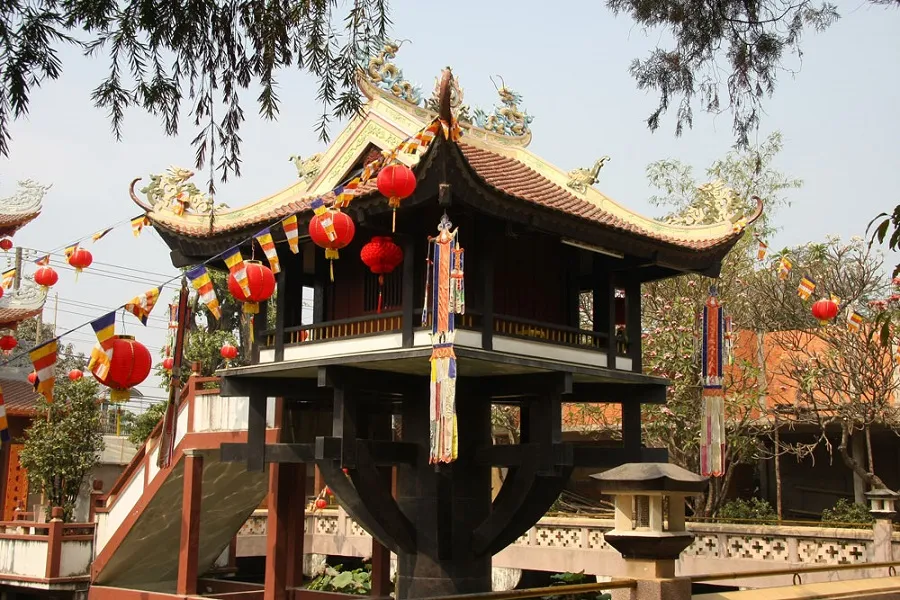
What to note when visiting One Pillar Pagoda?
To have an interesting and complete trip at Dien Huu Pagoda, you should pay attention to some tips below:
- Visiting time: You should go in the morning or afternoon to avoid the heat and crowds. You should spend about 30 minutes to 1 hour to visit the pagoda. The pagoda will open from 8 am to 5 pm every day.
- Transportation: You should go by bus or motorcycle to save costs and convenience. If you go by motorcycle, you should pay attention to traffic signs and do not enter prohibited areas.
- Clothing: Please choose polite clothes, not too short or revealing, to respect the sacred place and culture of the pagoda.
- Regulations: Follow the rules when entering the pagoda, such as not bringing pets, weapons or explosives, not bringing food or drinks into the pagoda, not smoking, chewing gum or talking loudly in the pagoda, not touching the worship items or historical artifacts in the pagoda,…
- Cost: You do not need to buy tickets to enter the pagoda, but you should prepare some money to buy incense and flowers, ask for fortune sticks, or support for the pagoda. You should also compare prices before buying food or souvenirs at the stalls near the pagoda.
One Pillar Pagoda is not only a destination for those who love to explore history and culture but also a sacred and important place in the minds of Vietnamese people. We hope that you and your family will have memorable and meaningful cultural experiences here!
Copyright © 2022 BDATrip.com | All rights reserved.